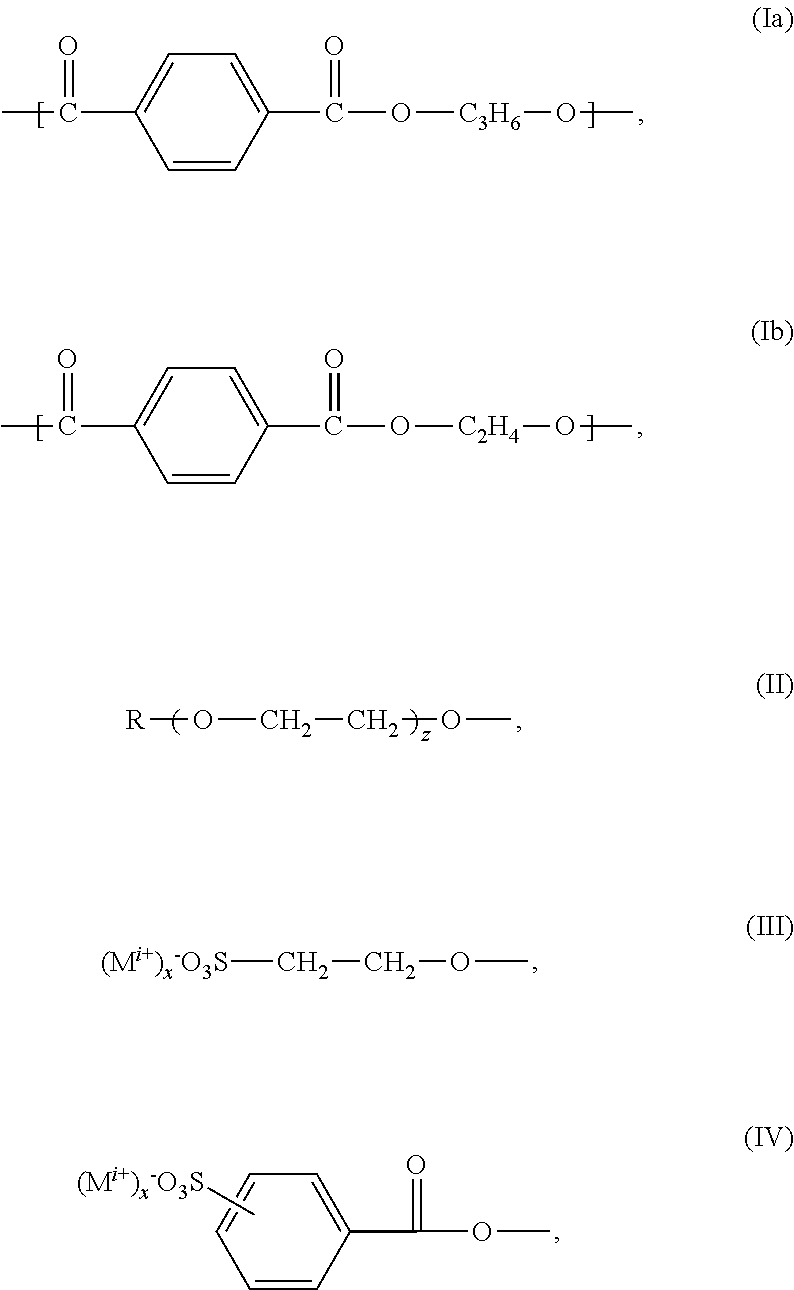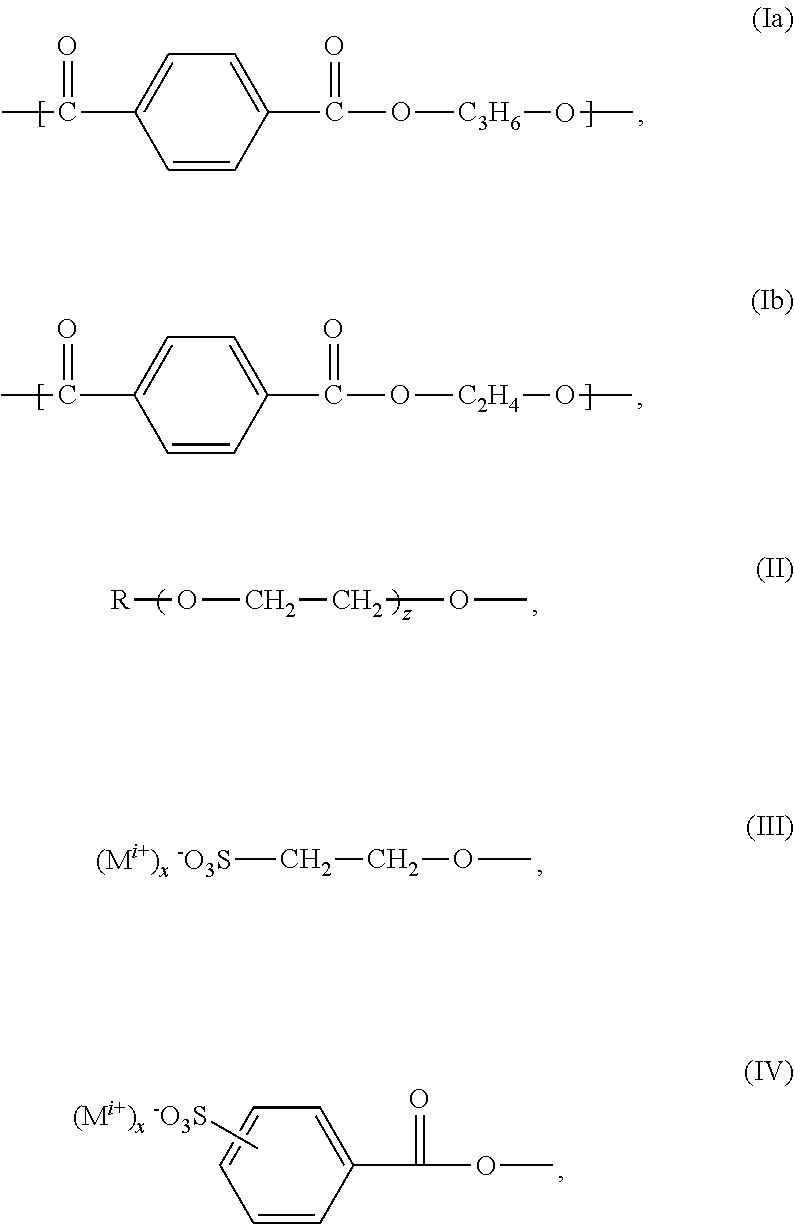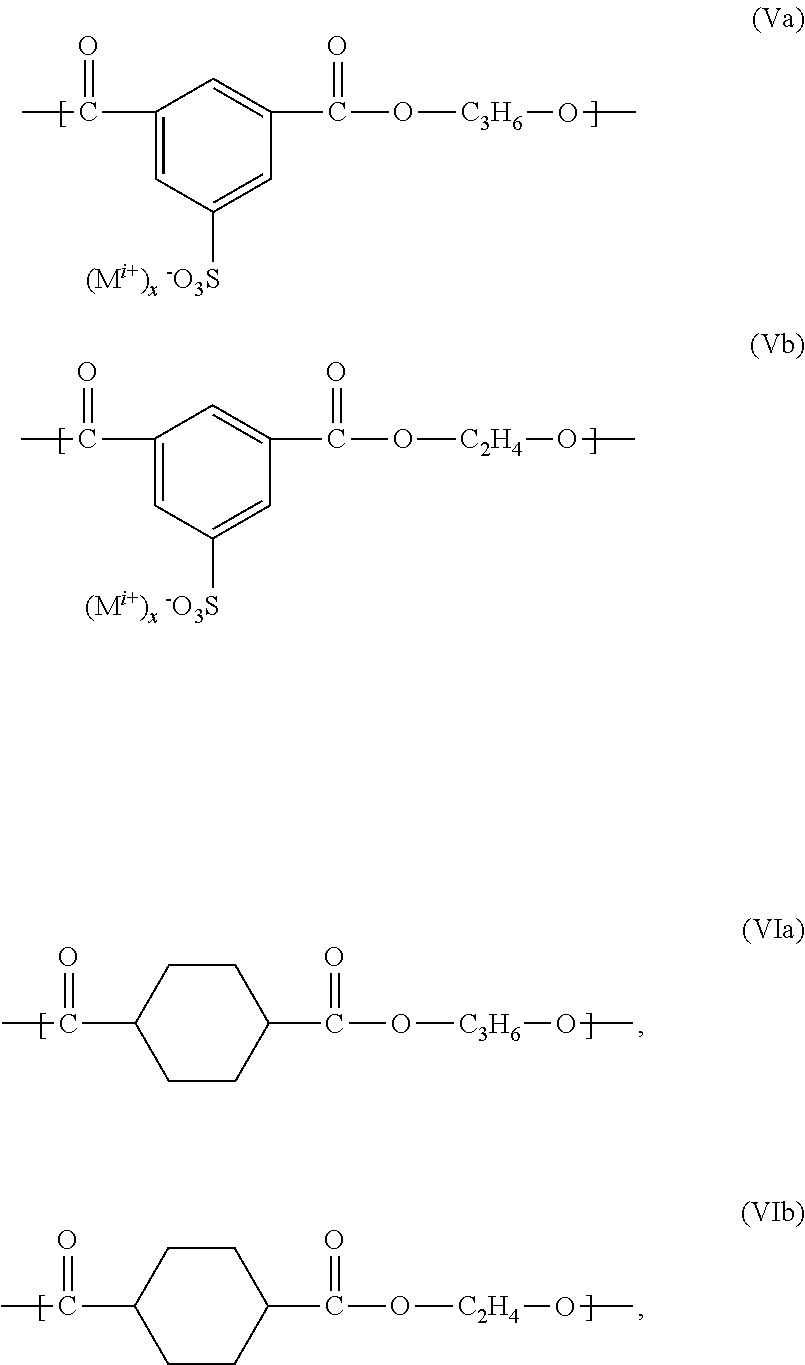Polyesters, Manufacturing Process Thereof and Their Use
a technology of polyester and manufacturing process, applied in the field of selected polyester, can solve the problems of difficult workability, anionic soil release polymer not fully satisfying the soil release effect, water solubility, dispersibility, hydrolytic stability, etc., and achieve excellent solubility and dispersibility in water.
- Summary
- Abstract
- Description
- Claims
- Application Information
AI Technical Summary
Benefits of technology
Problems solved by technology
Method used
Image
Examples
example 1 (
Polyester of the Invention)
[0124]194.1 g (1.00 mol) terephthalic acid dimethylester, 88.8 g (0.3 moles) 5-sulfo-isophthalic acid dimethylester sodium salt, 235.4 g (3.8 moles) ethylene glycol and 144.4 g (1.9 moles) 1,2-propylene glycol were successively added into a 2-liter four-necked round bottom flask equipped with KPG-stirrer, internal thermometer, gas inlet tube and distilling link. Subsequently additional 8.88 g (0.06 moles) isethionic acid sodium salt and 45 g polyethylene glycol monomethylether 750 (0.06 moles) were added to the reaction mixture.
[0125]Then, the reaction mixture was inerted by introducing nitrogen. In counterflow subsequently 2 g of titanium tetraisopropylate and 1 g of sodium acetate were added to the reaction mixture. The mixture was heated to about 165° C. and kept for an hour on temperature. At this temperature the transesterification began and the resulting methanol was distilled.
[0126]Two hours after start of the distillation the temperature was increa...
example 2 (
Polyester of the Invention)
[0127]555.48 g (3.75 moles) terephthalic acid dimethylester, 125.9 g (0.5 moles) 5-sulfo-isophthalic acid dimethylester sodium salt and 1162 g (20 moles) 1,2-propylene glycol were successively added into a 2-liter four-necked round bottom flask equipped with KPG-stirrer, internal thermometer, gas inlet tube and distilling link. Subsequently 215.37 g (1.00 mol) 3-sulfobenzoic acid sodium salt were added. Finally, 110 g polyethylene glycol monomethylether 550 were added to the reaction mixture.
[0128]Then, the reaction mixture was inerted by introducing of nitrogen. In counterflow subsequently 2 g of titanium tetraisopropylate and 1 g of sodium acetate were added to the reaction mixture. The mixture was heated to about 165° C. and kept for an hour on temperature. At this temperature the transesterification began and the resulting methanol was distilled.
[0129]One hour after start of the distillation the temperature was increased to 210° C. within 2 h. After fi...
example of 3 (
Polyester of the Invention)
[0130]72.8 g (0.375 moles) terephthalic acid dimethylester, 37.03 g (0.125 moles) 5-sulfo-isophthalic acid dimethylester sodium salt, 62.07 g (1 mol), ethylene glycol, 76.09 g (1 mol) 1,2-propane diol, 37.13 g (0.0675 moles) polyethylene glycol monomethyl ether (molar mass 550 g / mol), 10 g (0.0675 moles) 2-hydroxyethane sulfonic acid sodium salt and 0.45 g (0.0056 moles) waterfree sodium acetate were furnished into a 1-liter four-necked round bottom flask equipped with KPG-stirrer, internal thermometer, Vigreux column, distilling link, nitrogen transfer line (5 liter / h) and Anschitz-Thiele piping and the reaction mixture was subsequently heated to 60° C. inside temperature under nitrogen overlay (5 liters / hour) and stirring at a stirring rate of 50-100 rpm. After closure of the nitrogen overlay 0.75 g (0.0027 moles) of titanium tetraisopropylate were added. Subsequently, the stirring rate was increased to 300 rpm and the preparation was heated to 150° C. i...
PUM
| Property | Measurement | Unit |
|---|---|---|
| molar ratio | aaaaa | aaaaa |
| molar ratio | aaaaa | aaaaa |
| molar ratio | aaaaa | aaaaa |
Abstract
Description
Claims
Application Information
 Login to View More
Login to View More - R&D
- Intellectual Property
- Life Sciences
- Materials
- Tech Scout
- Unparalleled Data Quality
- Higher Quality Content
- 60% Fewer Hallucinations
Browse by: Latest US Patents, China's latest patents, Technical Efficacy Thesaurus, Application Domain, Technology Topic, Popular Technical Reports.
© 2025 PatSnap. All rights reserved.Legal|Privacy policy|Modern Slavery Act Transparency Statement|Sitemap|About US| Contact US: help@patsnap.com



